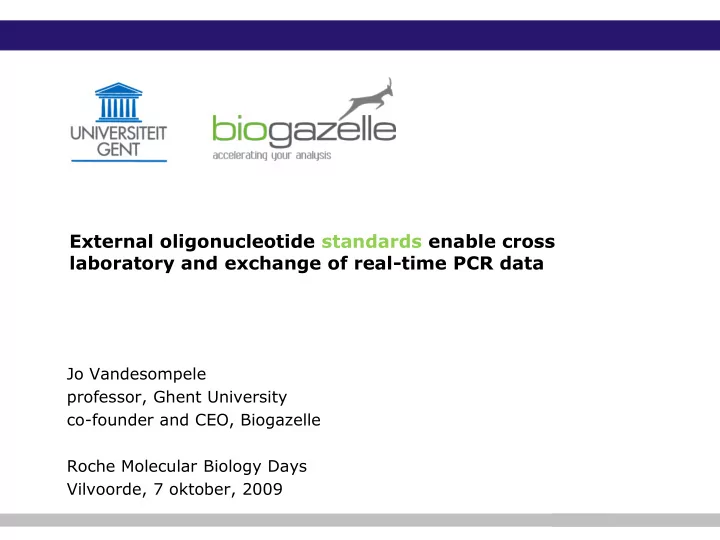

External oligonucleotide standards enable cross laboratory and exchange of real-time PCR data Jo Vandesompele professor, Ghent University co-founder and CEO, Biogazelle Roche Molecular Biology Days Vilvoorde, 7 oktober, 2009
biomarker signature based stratification
biomarker signature based stratification
study workflow • meta-analysis of 7 published microarray gene selection of a top expression studies ranking list of 59 • literature screening of almost 800 abstracts from prognostic markers single-gene studies RNA quality control 700 • two PCR-based assays samples • capillary gel electrophoresis (Experion) sample pre-amplification (WT-Ovation) qPCR assay design and • www.rtprimerdb.org validation real-time PCR 384-well plates (LC480) • Prediction Analysis of Microarrays qbase PLUS data-analysis • Kaplan-Meier • Cox proportional hazards
classification of patients with respect to PFS and OS PFS total SIOPEN cohort (n = 312) OS total SIOPEN cohort (n = 313) 100 100 LR n=245 (5) 80 80 survival probability (%) survival probability (%) LR n=245 (42) 60 60 HR n=68 (27) 40 40 HR n=67 (35) 20 20 p = <0.001 (log-rank) p = <0.001 (log-rank) 0 0 50 50 0 100 150 0 100 150 time (months) time (months)
value of the classifier in relation to currently used risk factors: PFS PFS age > 12 months (n = 142) PFS MYCN single copy (n = 265) PFS age <=12 months (n = 172) 100 100 100 survival probability (%) survival probability (%) survival probability (%) 80 80 80 LR n=152 (25) LR n=234 (39) LR n=94 (17) 60 60 60 40 40 40 HR n=48 (24) HR n=31 (18) HR n=20 (12) 20 20 20 p = <0.001 (log-rank) p = <0.001 (log-rank) p = <0.001 (log-rank) 0 0 0 0 50 100 150 0 50 100 150 0 50 100 150 time (months) time (months) time (months) PFS stage 4 (n = 58) PFS not stage 4 (n = 256) PFS MYCN amplification (n = 42 ) 100 100 100 survival probability (%) survival probability (%) survival probability (%) 80 80 80 LR n=222 (31) LR n=8 (1) 60 60 60 LR n=24 (11) HR n=34 (15) 40 40 40 HR n=34 (17) HR n=34 (21) 20 20 20 p = 0.12 (log-rank) p = <0.001 (log-rank) p = 0.22 (log-rank) 0 0 0 60 50 100 150 0 20 40 60 80 100 0 10 20 30 40 50 70 0 time (months) time (months) time (months)
Cox multivariate analysis PAM classifier multivariate cox analysis strong independent predictor: patients with high molecular risk have a 19-fold higher risk to die from disease a 4-fold higher risk for relapse/progression compared to patients with low molecular risk independent predictor (age, stage, MYCN)
Vermeulen et al., The Lancet Oncology, 2009
external oligonucleotide standards synthetic control FP stuffer RCRP 55 nucleotides PAGE purification blocking group 5 points dilution series: 150 000 molecules > 15 molecules
external oligonucleotide standards reproducibility across master mixes (5) and instruments (2) 35 30 25 MM1 20 MM2 MM3 MM4 15 MM5 10 5 0 1000000 100000 10000 1000 100 10
external oligonucleotide standards cross lab comparison 366 samples 5 standards (triplicates) 3 reference genes + 5 genes of interest
external oligonucleotide standards cross lab comparison 5 standards (triplicates) Cq qPCR instrument 1, mastermix 1 36 34 32 average Δ Cq standards 30 28 correction Cq samples 26 24 22 20 18 16 16 18 20 22 24 26 28 30 32 34 36 Cq qPCR instrument 2, mastermix 2
external oligonucleotide standards cross lab comparison ARHGEF7 gene 366 samples use of 5 standards (triplicates) for correction Cq 7900HT Cq LC480 abs (dCq)
external oligonucleotide standards cross lab comparison Vermeulen et al., Nucleic Acids Research, 2009
inter-run calibration requires specialized software data analysis using qbase PLUS based on Ghent University’s geNorm and qBase technology up to fifty 384-well plates multiple reference genes for accurate normalization detection and correction of inter-run variation o multiple IRC > more accurate o normalized relative quantities > greater flexibility dedicated error propagation automated analysis; no manual interaction required http://www.qbaseplus.com
conclusions standardization is hot in real-time PCR MIQE and RDML contribute to higher quality and transparency external oligonucleotides enable cross-laboratory studies
acknowledgements Jan Hellemans (UGent, Biogazelle) Filip Pattyn (UGent) Steve Lefever (UGent) Joëlle Vermeulen (UGent) MIQE & RDML consortium
January 28-29, 2010 Ghent, Belgium www.advances-in-genomics.org early bird registration October 31, 2009
Recommend
More recommend